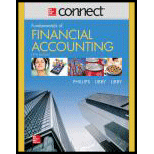
Connect 1 Semester Access Card for Fundamentals of Financial Accounting
5th Edition
ISBN: 9781259128547
Author: Fred Phillips Associate Professor, Robert Libby, Patricia Libby
Publisher: McGraw-Hill Education
expand_more
expand_more
format_list_bulleted
Question
Chapter AC, Problem AC.2E
1.
To determine
Compute the amount that A deposited on January 1.
2.
To determine
Compute the interest for the 4 years.
Expert Solution & Answer
Want to see the full answer?
Check out a sample textbook solution
Students have asked these similar questions
Solve this Accounting Problem
Help
general accounting question
Chapter AC Solutions
Connect 1 Semester Access Card for Fundamentals of Financial Accounting
Ch. AC - Prob. 1QCh. AC - Prob. 2QCh. AC - Which of the following is most likely to be an...Ch. AC - Prob. 4QCh. AC - Prob. 5QCh. AC - Prob. 6QCh. AC - Prob. 7QCh. AC - You are saving up for a Mercedes-Benz SLR McLaren,...Ch. AC - Prob. 2MCCh. AC - Prob. 3MC
Ch. AC - Prob. 4MCCh. AC - Prob. 5MCCh. AC - Assume you bought a car using a loan that requires...Ch. AC - Assume you bought a car using a loan that requires...Ch. AC - Which of the following statements is true? a. When...Ch. AC - Prob. 9MCCh. AC - Prob. 10MCCh. AC - Prob. AC.1MECh. AC - Prob. AC.2MECh. AC - Prob. AC.3MECh. AC - Prob. AC.4MECh. AC - Prob. AC.5MECh. AC - Prob. AC.6MECh. AC - Prob. AC.7MECh. AC - Prob. AC.8MECh. AC - Prob. AC.9MECh. AC - Prob. AC.10MECh. AC - Prob. AC.11MECh. AC - Prob. AC.12MECh. AC - Prob. AC.1ECh. AC - Prob. AC.2ECh. AC - Prob. AC.3ECh. AC - Prob. AC.4ECh. AC - Prob. AC.5ECh. AC - Computing Bond Issue Proceeds and Issue Price Your...Ch. AC - Computing Missing Present or Future Values...Ch. AC - Comparing Options Using Present Value Concepts...Ch. AC - Prob. AC.2CPCh. AC - Prob. AC.3CPCh. AC - Prob. AC.4CPCh. AC - Prob. AC.1PACh. AC - Recording Equipment Purchase with Two-Year Note...Ch. AC - Prob. AC.3PACh. AC - Prob. AC.4PACh. AC - Prob. AC.1PBCh. AC - Recording Equipment Purchase with Two-Year Note...Ch. AC - Prob. AC.3PBCh. AC - Prob. AC.4PB
Knowledge Booster
Learn more about
Need a deep-dive on the concept behind this application? Look no further. Learn more about this topic, accounting and related others by exploring similar questions and additional content below.Similar questions
- nonearrow_forwardAfirm has an asset with a market value of $10,000 and a book value of $4,000. If its marginal tax rate is 25%, what will the net proceeds from selling the assetbe?arrow_forwardI am looking for the correct answer to this general accounting problem using valid accounting standards.arrow_forward
- Accountingarrow_forwardQuestion: Aho firm has actual sales of $69,000 in April and $57,000 in May. It expects sales of$74,000 in June and $97,000 in July and in August. Assuming that sales are the only source of cash inflows and that half of them are for cash and theremainder are collected evenly over the following 2 months, what are the firm's expected cash receipts for June, July, and August?arrow_forwardCan you help me solve this general accounting question using the correct accounting procedures?arrow_forward
- Hi expert please given correct answer with accounting questionarrow_forwardFinancial Accounting Question: A new common stock issue that paid a $1.77 dividend last year. The parvalue of the stock is $15, and the firm's dividends per share have grown at a rate of 7.8% per year. The growth rate is expected to continue in the foreseeable future. The price of this stock is now 27.33. The cost of common equity for the firm is __%.arrow_forwardCan you solve this general accounting question with the appropriate accounting analysis techniques?arrow_forward
- I am searching for the accurate solution to this general accounting problem with the right approach.arrow_forwardFinancial Accounting Question: A new common stock issue that paid a $1.77 dividend last year. The parvalue of the stock is $15, and the firm's dividends per share have grown at a rate of 7.8% per year. The growth rate is expected to continue in the foreseeable future. The price of this stock is now 27.33. The cost of common equity for the firm is __%.Need Answerarrow_forwardPlease provide the accurate answer to this general accounting problem using valid techniques.arrow_forward
arrow_back_ios
SEE MORE QUESTIONS
arrow_forward_ios
Recommended textbooks for you
 Intermediate Accounting: Reporting And AnalysisAccountingISBN:9781337788281Author:James M. Wahlen, Jefferson P. Jones, Donald PagachPublisher:Cengage Learning
Intermediate Accounting: Reporting And AnalysisAccountingISBN:9781337788281Author:James M. Wahlen, Jefferson P. Jones, Donald PagachPublisher:Cengage Learning Financial Accounting: The Impact on Decision Make...AccountingISBN:9781305654174Author:Gary A. Porter, Curtis L. NortonPublisher:Cengage Learning
Financial Accounting: The Impact on Decision Make...AccountingISBN:9781305654174Author:Gary A. Porter, Curtis L. NortonPublisher:Cengage Learning Cornerstones of Cost Management (Cornerstones Ser...AccountingISBN:9781305970663Author:Don R. Hansen, Maryanne M. MowenPublisher:Cengage Learning
Cornerstones of Cost Management (Cornerstones Ser...AccountingISBN:9781305970663Author:Don R. Hansen, Maryanne M. MowenPublisher:Cengage Learning Pfin (with Mindtap, 1 Term Printed Access Card) (...FinanceISBN:9780357033609Author:Randall Billingsley, Lawrence J. Gitman, Michael D. JoehnkPublisher:Cengage Learning
Pfin (with Mindtap, 1 Term Printed Access Card) (...FinanceISBN:9780357033609Author:Randall Billingsley, Lawrence J. Gitman, Michael D. JoehnkPublisher:Cengage Learning

Intermediate Accounting: Reporting And Analysis
Accounting
ISBN:9781337788281
Author:James M. Wahlen, Jefferson P. Jones, Donald Pagach
Publisher:Cengage Learning

Financial Accounting: The Impact on Decision Make...
Accounting
ISBN:9781305654174
Author:Gary A. Porter, Curtis L. Norton
Publisher:Cengage Learning



Cornerstones of Cost Management (Cornerstones Ser...
Accounting
ISBN:9781305970663
Author:Don R. Hansen, Maryanne M. Mowen
Publisher:Cengage Learning

Pfin (with Mindtap, 1 Term Printed Access Card) (...
Finance
ISBN:9780357033609
Author:Randall Billingsley, Lawrence J. Gitman, Michael D. Joehnk
Publisher:Cengage Learning
5 Steps to Setting Achievable Financial Goals | Brian Tracy; Author: Brian Tracy;https://www.youtube.com/watch?v=aXDuLxEJqBo;License: Standard Youtube License